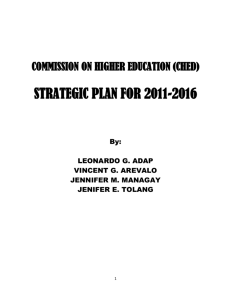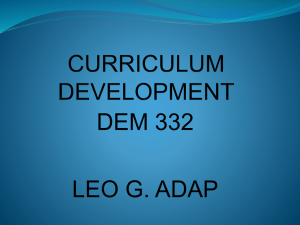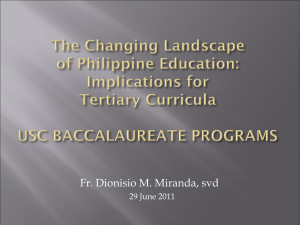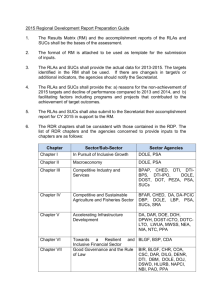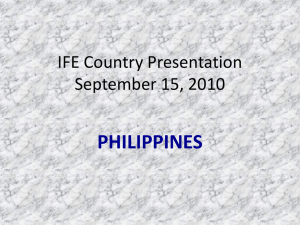Philippines
advertisement
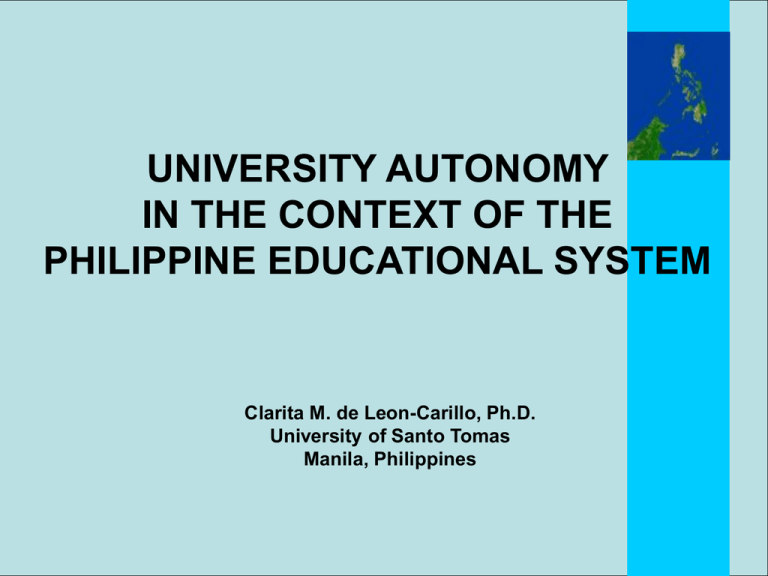
UNIVERSITY AUTONOMY IN THE CONTEXT OF THE PHILIPPINE EDUCATIONAL SYSTEM Clarita M. de Leon-Carillo, Ph.D. University of Santo Tomas Manila, Philippines National Regional Institutional Public and Private HEIs Fig. 1. HEIs’ Ecology of Legislations Some relevant Constitutional provisions directly expressing the role of the State in education : The State shall protect and promote the right of all citizens to quality education at all levels and shall take appropriate steps to make such education accessible to all” (Article XIV, Sec. 1). The State recognizes the complementary roles of public and private institutions in the educational system and shall exercise reasonable supervision and regulation of all educational institutions” (Article XIV, Sec. 4:1) Some relevant Constitutional provisions directly expressing the role of the State in education : Educational institutions, other than those established by religious groups and mission boards, shall be owned solely by citizens of the Philippines or corporations or associations at least sixty per centum of the capital of which is owned by such citizens. The Congress may, however, require increased Filipino equity participation in all educational institutions. The control and administration of educational institutions shall be vested in citizens of the Philippines (Article XIV, Sec. 4:2). Some relevant Constitutional provisions directly expressing the role of the State in education : The State shall take into account regional and sectoral needs and conditions and shall encourage local planning in the development of educational policies and programs (Article XIV, Sec. 5:1). Academic freedom shall be enjoyed in all institutions of higher learning (Article XIV, Sec. 5:2). Creation of the Commission on Higher Education • governing body that covers both public and private higher education institutions in the Philippines • established on May 18, 1994 through Republic Act 7722, also known as the Higher Education Act of 1994 • created in view of the broad agenda for reforms which resulted from the Congressional Commission on Education (EDCOM) Report 1991 under the leadership of Senator Edgardo Angara. Creation of the Commission on Higher Education Trifocalization of the education sector in the country: Department of Education, Culture and Sports (DECS) Commission on Higher Education (CHED) Department of Education (DepEd) Technical Education and Skills Development Authority (TESDA) Directionsetting/policy formulation General supervision CHED Powers and Functions Quality assurance. monitoring, and evaluation Fiscal / Funds management Powers and Functions of CHED Tasks Powers and Functions (R.A. 7722) Directionsetting/policy formulation formulate and recommend development plans, policies, priorities, and programs on higher education and research; recommend to the executive and legislative branches, priorities and grants on higher education and research; direct or redirect purposive research by institutions of higher learning to meet the needs of agro-industrialization and development Powers and Functions of CHED Tasks Powers and Functions (R.A. 7722) Quality assurance, monitoring, and evaluation set minimum standards for programs and institutions of higher learning recommended by panels of experts in the field and subject to public hearing, and enforce the same; monitor and evaluate the performance of programs and institutions of higher learning for appropriate incentives as well as the imposition of sanctions such as, but not limited to, diminution or withdrawal of subsidy, recommendation on the downgrading or withdrawal of accreditation, program termination or school closure; Powers and Functions of CHED Tasks Powers and Functions (R.A. 7722) Quality assurance, monitoring, and evaluation identify, support and develop potential centers of excellence in program areas needed for the development of world-class scholarship, nation building and national development; rationalize programs and institutions of higher learning and set standards, policies and guidelines for the creation of new ones as well as the conversion or elevation of schools to institutions of higher learning, subject to budgetary limitations and the number of institutions of higher learning in the province or region where creation, conversion or elevation is sought to be made; Powers and Functions of CHED Tasks Powers and Functions (R.A. 7722) Fiscal / Funds management recommend to the Department of Budget and Management the budgets of public institutions of higher learning as well as general guidelines for the use of their income; develop criteria for allocating additional resources such as research and program development grants, scholarships, and other similar program; provided, that these shall not detract from the fiscal autonomy already enjoyed by colleges and universities; Powers and Functions of CHED Tasks Powers and Functions (R.A. 7722) Fiscal / Funds management devise and implement resource development schemes; administer the Higher Education Development Fund, which will promote the purposes of higher education; Powers and Functions of CHED Tasks Powers and Functions (R.A. 7722) General supervision review the charters of institutions of higher learning and state universities and colleges including the chairmanship and membership of their governing bodies and recommend appropriate measures as basis for necessary action; promulgate such rules and regulations and exercise such other powers and functions as may be necessary to carry out effectively the purpose and objectives of this Act; and perform such other functions as may be necessary for its effective operations and for the continued enhancement, growth or development of higher education. Higher Education Institutions (HEIs) public 522 26% private 1494 74% As of December 2007, there have been about 2016 higher education institutions in the country that are distributed among 17 regions. PUBLIC HIGHER EDUCATION INSTITUTIONS • 110 state universities and colleges (SUCs) with main campuses;326 satellite campuses • 70 local universities and colleges (LUCs) • 1 CHED-supervised institution (CSI) • 10 other government schools (OGS) • 5 special HEIs Public Higher Education Institutions State Universities and Colleges (SUCs) • established by law and thus have their own charter • administered and funded by the national government • governed by a Board of Regents (state universities) or a Board of Trustees (state colleges) headed by the CHED Chair or a CHED Commissioner (CMO 3 series 2001) • the HEI president, staff and support units are vested with the power to implement policies formulated and approved by the Board and have direct administration and management of the HEI Public Higher Education Institutions Local Universities and Colleges (LUCs) • established through resolutions and ordinances approved by the local government units and are therefore subsidized by them. Public Higher Education Institutions CHED-Supervised Institution (CSI) • a non-chartered, post-secondary institution established by law • administered, supervised, and financially supported by the national government Public Higher Education Institutions Other Government Schools (OGS) • usually technical-vocational educational institutions that offer higher education programs • funded by national and local government units Public Higher Education Institutions Special HEIs • created through special laws that stipulate specifically the government agency that shall administer and supervise them Public Higher Education Institutions CHED rationalization of the program offerings of SUCs on a regional basis specialization in each SUC Specialization intraregionally among SUCs agriculture, technology and engineering, and technical education better regional coordination among SUCs X duplication of program offerings and the overlapping of target markets. Higher Education Institutions (HEIs) public 522 26% private 1494 74% As of December 2007, there have been about 2016 higher education institutions in the country that are distributed among 17 regions. PRIVATE HIGHER EDUCATION INSTITUTIONS Earlier figures showed that the private sector accounts for a larger percentage of higher education institutions, making it the major provider of the country’s educational services (CHED Report 2008). Private Higher Education Institutions Sectarian Non-sectarian non-stock, non-profit duly incorporated academic institutions that are owned and operated by religious groups or organizations duly incorporated academic institutions, owned and operated by private entities that are not affiliated to any religious organization. • In both cases, these HEIs are established under, and are governed by the special laws and general provisions of, the Corporation Code of the Philippines. Private Higher Education Institutions • Though financed independently from government budget, private HEIs must follow the requirements set by CHED as contained in its policies, standards and guidelines (PSGs). • Said PSGs cover program offerings, curricula, set academic qualifications for administrators and faculty. Private Higher Education Institutions • Further, private HEIs must also comply with the provisions of the Manual of Regulations for Private Schools (MRPS) which set the general policies and/or minimum standards for internal organization, faculty qualifications, school finance and administration, school facilities, student admission, records and graduation requirements, among others. Private Higher Education Institutions • Generally, private HEIs obtain funding from their own capital investments, equity contributions, tuition fees and other school charges, grants, loans, subsidies and other income sources in accordance with current legislation. • In some instances, special grants and scholarships are extended by the national and local government agencies. Academic Freedom Autonomous and deregulated status IQUAME AUTONOMY AND DEREGULATION Centers of Excellence and Development Program Accreditation Institutional Accreditation AUTONOMY AND DEREGULATION a. Academic Freedom • The 1935 Constitution provided that “(u)niversities established by the state shall enjoy academic freedom.” • The 1973 Constitution, on the other hand, offered something different when it provided that “(a)ll institutions of higher learning shall enjoy academic freedom.” Academic Freedom Under the 1987 Constitution, institutional academic freedom consists of four essential freedoms: (1) who may teach (2) what may be taught (3) how it shall be taught (4) who may be admitted to study Academic Freedom (1) Who may teach • discretion in the appointment of academic personnel in accordance with its standards of competence and probity • a prerogative that is almost absolute, limited only by existing laws against discrimination Academic Freedom (2) What and (3) How to Teach • the institutional right “to decide for itself its aims and objectives and how best to attain them, free from outside coercion or interference save possibly when the overriding public welfare calls for some restraint, and with a wide sphere of autonomy certainly extending to the choice of students.” (Garcia vs. Faculty Admissions Committee, 68 SCRA 283, 1975) Academic Freedom (4) Who may study • prerogative to determine through its own set of rules who could be allowed the opportunity to study • admission rules may vary depending on whether institutions of higher learning are private or public institutions • right to promulgate or set academic standards for students’ observance, again subject to the existing law and jurisprudence. AUTONOMY AND DEREGULATION b. Autonomous and Deregulated Status (CMO 32 series 2001) In recognition of: (a) “the enormous contribution of private higher education institutions in the growth and prominence of tertiary education in the country and in the AsiaPacific” (b) the formidable and demanding task of supervising the 2016 PHEIs, and thus the need to rationalize their supervision Autonomous and Deregulated Status Long tradition of integrity and untarnished reputation Commitment to excellence Sustainability and viability of operations Autonomous and Deregulated Status 1. Long tradition of integrity and untarnished reputation This attribute is ascribed to a higher education institution that has consistently adhered to existing laws, rules and regulations and has no record of confirmed violations of Philippine laws, CHED Memorandum Orders (CMOs), and PSGs; and has established processes for addressing administrative and disciplinary cases. Autonomous and Deregulated Status 2. Commitment to excellence The HEI demonstrates academic excellence as evidenced by: • the designation of its programs as Center of Excellence (COE) or Center of Development (COD) • its accreditation status • the PHEI’s attainment of the required Institutional Monitoring and Evaluation for Quality Assurance in Higher Education (IQUAME) category Autonomous and Deregulated Status 2. Commitment to excellence • All forms of existing quality assurance mechanisms applicable to Philippine higher education institutions are considered • Performance in licensure examinations is excluded as a separate criterion since it is already taken into consideration in the identification of COEs/CODs, level of accredited programs and IQUAME classification Autonomous and Deregulated Status 3. Sustainability and viability of operations • The HEI shows its capability to sustain operations and is able to provide evidence of stable student enrolment for a least the last five years. • Its enrolment and admission policies must be in line with the institution’s Vision, Mission and Goals. • Its key administrators (President, Vice-President, Dean, Director, Librarian and Registrar) are able to meet the educational qualifications specified by CHED. Table 4. Comparative table of privileges and benefits granted to autonomous and deregulated PHEIs Benefits and privileges Autono mous Status Deregu lated Status Free from regular monitoring and evaluation by CHED. Priority in the granting of subsidies and other financial incentives/ assistance from the CHED whenever funds are available. Privilege to determine and prescribe their curricular programs to achieve global competence. Privilege to offer new course(s)/ program(s) in undergraduate level and, at the graduate level, in their areas of expertise as indicated by their accreditation status, without securing permit/authority from CHED except in disciplines that are under moratorium. Table 4. Comparative table of privileges and benefits granted to autonomous and deregulated PHEIs Benefits and privileges Autono mous Status Deregu lated Status Privilege to establish branch(es) or satellite campus(es) without securing authority from CHED. Privilege to offer extension classes to expand access to higher education. Privilege to establish linkages with recognized foreign higher education institutions. Authority to grant an honorary degree to deserving individuals, per provisions of the existing CHED issuance on conferment of honorary degrees. All other benefits and privileges of PHEIs as provided for under CHED Memorandum Order No. 1, series of 2005 entitled “Revised Policies and Guidelines on Voluntary Accreditation in Aid of Quality and Excellence in Higher Education.” AUTONOMY AND DEREGULATION c. Accreditation of Academic Programs The degree of autonomy thus granted by CHED to PHEIs considers these institutions’ ability to observe and manifest their commitment to excellent standards of instruction, research, community and extension services. To a large extent, such standards need to have been validated previously by external evaluators through an accreditation process voluntarily undertaken by institutions (CMO 01 series 2005) under any of the accrediting agencies under the Federation of Accrediting Agencies in the Philippines (FAAP). Accreditation of Academic Programs Accrediting Agencies Philippine Association of Colleges and Universities Commission on Accreditation (PACUCOA) Philippine Accrediting Association of Schools, Colleges, and Universities (PAASCU) Association of Christian Schools, Colleges and Universities Accrediting Agency, Inc. (ACSCU-AAI) Accrediting Agency of Chartered Colleges and Universities of the Philippines (AACCUP) Association of Local Colleges and Universities Commission on Accreditation (ALCUCOA). Accreditation of Academic Programs These various agencies grant program accreditation through an evaluation of several areas: purposes and objectives faculty instruction laboratories library resources physical plant and facilities student personnel services social orientation and community involvement organization and administration Table 5. Benefits per Program Accreditation Level Benefit Accreditation Level 1-2 3 4 Financial deregulation in terms of setting of tuition and other school fees and charges Authority to revise the curriculum without prior CHED approval Authority to graduate students from accredited programs without prior approval from CHED and without need of Special Orders Priority on the awards of grants/subsidies or funding assistance from CHED-Higher Education Development Fund for scholarships and faculty development, facilities improvement and other development programs Right to use in its publications or advertisements the word “ACCREDITED” Full administrative deregulation Table 5. Benefits per Program Accreditation Level Benefit Accreditation Level 1-2 3 4 Limited visitation, inspection and/or supervision by CHED supervisory personnel or representatives Authority to offer new courses allied to existing level 3 programs without need for prior approval Privilege to apply for authority to offer new graduate programs, open learning/distance education, extensiuon classes and to participate in transnational education Full autonomy for the program for the duration of its status Authority to offer new graduate programs allied to existing Level 4 programs, open learning/distance education and extension cases without need for prior approval by CHED AUTONOMY AND DEREGULATION d. Institutional Accreditation Benefits: • All the benefits for Level III • Grant of full autonomy for the program for the duration of its level IV accredited status • Authority to offer new graduate programs allied to existing level IV courses; open/distance education and extension classes without need for prior approval by CHED provided that the concerned CHEDRO is duly informed AUTONOMY AND DEREGULATION e. Centers of Excellence and Centers of Development Center of Excellence (COE) - a unit within any higher education institution (HEI) with (i) a strong graduate program and (ii) an undergraduate program that meets international standards of academic quality and excellence. Center of Development (COD) - a unit within any higher education institution with a strong undergraduate program and a strong potential to develop its faculty and its capability in research. AUTONOMY AND DEREGULATION e. Centers of Excellence and Centers of Development full administrative, financial and curricular deregulation authority to graduate students without prior approval of the CHED and without the need for Special Orders priority in terms of available funding assistance for scholarships, faculty development, library materials, development activities limited visitation, inspection and/or supervision by the CHED Table 6. Criteria for the Selection of COEs and CODs Evaluation Areas: Administration Faculty Resources Curriculum Laboratories Library Information Technology Capability Student support system Performance in Licensure Examinations Graduate Profile Graduate Tracer Study Research Publication Extension and linkages Institutional Qualification Centers of Excellence (COEs) and Centers of Development (CODs) Together with the expectations ascribed to PHEIs that house COEs/CODs, however, are benefits that come in the form of prioritized financial support from CHED that pertain to graduate scholarships, thesis/dissertation grants, faculty development and upgrading, material, equipment and software acquisition, instructional materials development, and research activities. AUTONOMY AND DEREGULATION f. Institutional Quality Assurance, Monitoring, and Evaluation (IQUAME) Five (5) key result areas: • governance and management • quality of teaching and research • support for students • relations with the community • management of resources. Minimum Quality Standards Increasing levels of program accreditation Institutional accreditation, COE/COD status, IQuaME certification Autonomous and deregulated status High Quality Standards Institutional autonomy Government monitoring and supervision Fig. 2. Continuum of University Autonomy Thank you!
